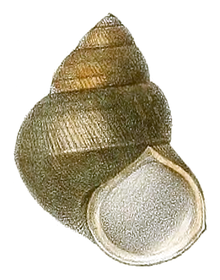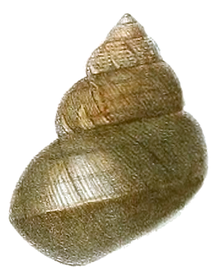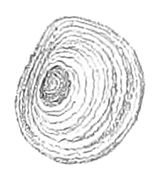| Filopaludina martensi | |
|---|---|

| |
| Drawing of an apertural view of a shell of Filopaludina martensi | |

| |
| Abapertural view of a shell | |
| Scientific classification | |
| Kingdom: | |
| Phylum: | |
| Class: | |
| (unranked): | |
| Superfamily: | |
| Family: | |
| Genus: | |
| Subgenus: | Siamopaludina
|
| Species: | F. martensi
|
| Binomial name | |
| Filopaludina martensi (Frauenfeld, 1864)[2]
| |
| Synonyms[1] | |
Filopaludina martensi is a species of large freshwater snail with a gill and an operculum, an aquatic gastropod mollusk in the family Viviparidae.
Description
The shape of the shell is ovate-conic.[3] The apex is acute and violet-black in colour.[3] The umbilicus of the shell is very narrow.[3] There are fine spiral lines on the shell.[3] The color of the shell is green or dark brown-blackish.[3] The shell has 6–7 convex whorls.[3] Whorls are with upper spiral lines, some are obsolescently sculptured.[3] The last whorl is swollen.[3]
The aperture is oblique, ovately rounded.[3] The aperture is cerulean-white in colour.[3] The upper part of the aperture is not acute.[3] The peristome is straight, thick, blunt, often outwardly blackish.[3]
The width of the shell is up to 31 millimetres (1.2 in).[3] The height of the shell is up to 55 millimetres (2.2 in).[3] The length of the aperture is up to 21 millimetres (0.83 in).[3]
The operculum has the color of horn with golden shining and it is widely ovate. There are concentric lines on the operculum.[3]
-
Outer side of an operculum
-
Inner side of an operculum
Taxonomy
This species was firstly described by Eduard von Martens under the name Paludina cingulata in 1860 based on specimen collected by Henri Mouhot.[3] Georg Ritter von Frauenfeld created a new replacement name Vivipara martensi for this species in 1864, because the name Vivipara cingulata was already used for a fossil species by Philippe Matheron before.[2]
Subspecies
Three subspecies are recognized,[1] but this species and its subspecies require revision.[1]
- Filopaludina martensi cambodiensis Brandt, 1974[1]
- Filopaludina martensi martensi (Frauenfeld, 1864)
- Filopaludina martensi munensis Brandt, 1974[1]
Distribution
This species is found in Cambodia, Indonesia, Laos, Malaysia, Thailand and Vietnam.[1] The type locality is "Siam" (a detailed type locality was not given).[3]
Ecology
Filopaludina martensi lives in canals and ponds.[4] It feeds (as do all other Viviparidae) as a filter feeder.[4] There are in development 0–14 juveniles in a brood-pouch of a female.[5] Female gave birth to juveniles mainly at night.[5] Parasites of Filopaludina martensi martensi include:
- Paragonimus siamensis as the first intermediate host.[6]
- at least three species of Echinostomatidae[7]
Parasites of Filopaludina martensi include trematode Multicotyle purvisi.[8]
Human use
Filopaludina martensi is used as part of the cuisine of Thailand.[4]
References
- This article incorporates public domain text from Martens, 1860
- ^ a b c d e f g Köhler F., Sri-aroon P. & Simonis J. (2012). "Filopaludina martensi". In: IUCN 2012. IUCN Red List of Threatened Species. Version 2012.2. <www.iucnredlist.org>. Downloaded on 9 November 2012.
- ^ a b c (in German) von Frauenfeld G. R. (1864). "Verzeichnis der Namen der fossilen und lebenden Arten der Gattung Paludina Lam.". Verhandlungen der Kaiserlich-Königlichen Zoologisch-Botanischen Gesellschaft in Wien 14: 561–672. page 588.
- ^ a b c d e f g h i j k l m n o p q r s Martens E. v. (1860). "On the Mollusca of Siam". Proceedings of the Zoological Society of London 1860(1): 6–18, page 13.
- ^ a b c Piyatiratitivorakul, Piansiri; Boonchamoi, Pachanee (2008). "Comparative toxicity of mercury and cadmium to the juvenile freshwater snail, Filopaludina martensi martensi". ScienceAsia. 34 (4): 367. doi:10.2306/scienceasia1513-1874.2008.34.367.
- ^ a b Berry, A. J. (2009). "Reproductive condition in two Malayan freshwater viviparid gastropods". Journal of Zoology. 174 (3): 357–367. doi:10.1111/j.1469-7998.1974.tb03163.x..
- ^ Yaemput, S; Dekumyoy, P; Visiassuk, K (1994). "The natural first intermediate host of Paragonimus siamensis (Miyazaki and Wykoff, 1965) in Thailand". The Southeast Asian Journal of Tropical Medicine and Public Health. 25 (2): 284–90. PMID 7855641.
- ^ Noikong, W.; Wongsawad, C.; Chai, J.-Y.; Saenphet, S.; Trudgett, A. (2014). "Molecular Analysis of Echinostome Metacercariae from Their Second Intermediate Host Found in a Localised Geographic Region Reveals Genetic Heterogeneity and Possible Cryptic Speciation". PLOS Neglected Tropical Diseases. 8 (4): e2778. doi:10.1371/journal.pntd.0002778. PMC 3974680. PMID 24699358.
- ^ Alevs, Philippe V.; Vieira, Fabiano M.; Santos, Cláudia P.; Scholz, Tomáš; Luque, José L. (12 February 2015). "A Checklist of the Aspidogastrea (Platyhelminthes: Trematoda) of the World". Zootaxa. 3918 (3): 339–396. doi:10.11646/zootaxa.3918.3.2. ISSN 1175-5334. PMID 25781098.
External links
- Taeme, Janta; Kruatrachue, Maleeya; Kaewsawangsap, Somboon; Chitramvong, Yaowaluk; Sretarugsa, Prapee; Upatham, E. Suchart (1996). "ACUTE TOXICITY AND BIOACCUMULATION OF LEAD IN THE SNAIL, FILOPALUDINA (SIAMOPALUDINA) MARTENSI MARTENSI (FRAUENFELDT)". ScienceAsia. 22 (3): 237. doi:10.2306/scienceasia1513-1874.1996.22.237.
- Kobelt W. (1909). "Die Gattung Paludina Lam. (Vivipara Montfort) (Neue Folge). In Abbildungen nach der Natur mit Beschreibungen". Systematisches Conchylien-Cabinet von Martini und Chemnitz, Nürnberg, 1(21a): pp. 97–430, plates 15–77., page 203–204, table 41, fig. 7–8.



